Incubators
All modern incubators work on the same basic principles. A fan blows filtered ambient air over a heating element and a water container. Through a control valve additional oxygen can be supplied to the air. The moistened, heated, and enriched air now flows into the cabinet with the baby. One part of the air escapes from the cabinet through vent holes, another part gets back into the air processing.
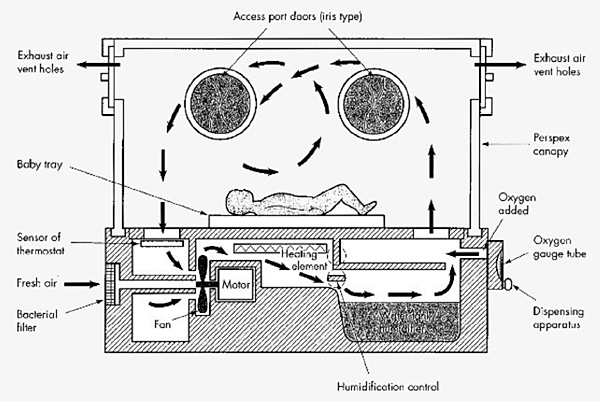
The diagram and design summary above is from Frank Weithoener’s excellent web page at http://www.frankshospitalworkshop.com/equipment/infant_incubators_equipment.html. For more information, click the link.
Early Incubators
The photos of incubators through the years below demonstrate how thinking and technology has evolved over the last hundred years, eventually converging on the functionality found in all modern incubators.
The first known incubator was developed at the Imperial Foundling Hospital in St. Petersburg, built by an unknown craftsman under the direction of Von Ruehl, physician to Czarina Feodorovna, wife of Czar Paul 1. By 1850 some 40 of these incubators were used in the Moscow Foundling Hospital.
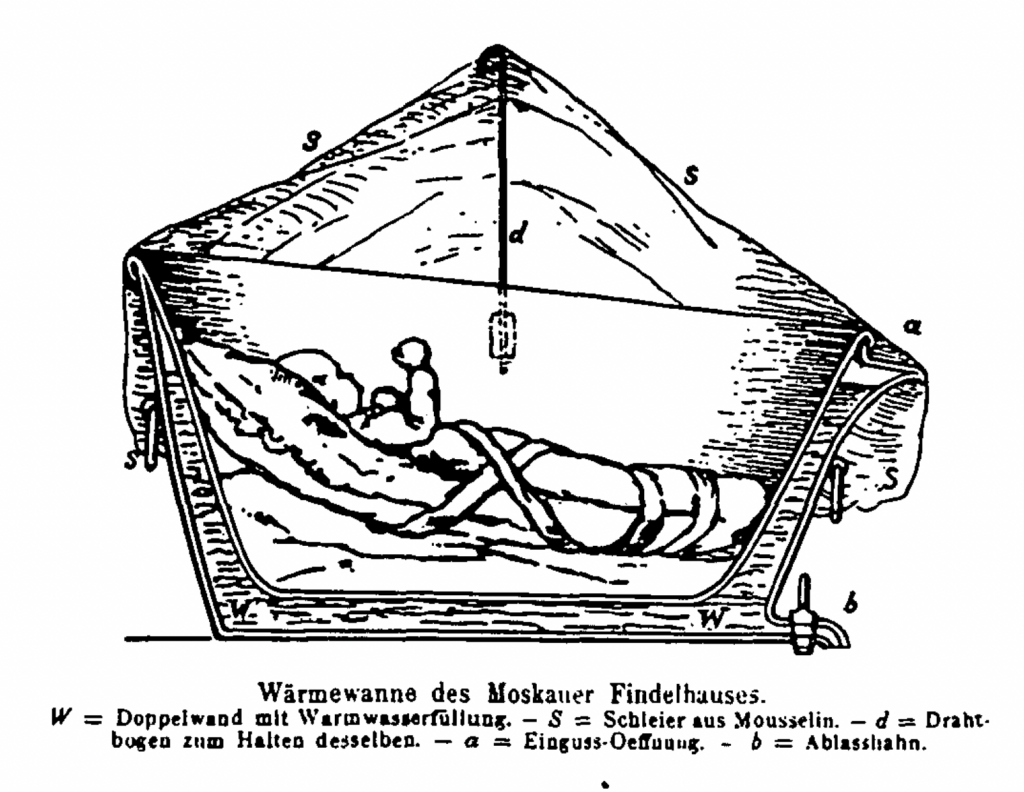
Denucé is often credited with the first publication of a warming device for premature and sick infants in 1857, Dr. Stéphane Tarnier, a Paris obstetrician, is credited with the formulation of the first incubator as we know them today – a glass-warmed box for with a warming source for environmental control, infection control, and the ability to observe the baby without disturbing it or exposing it to cold air. Reportedly, Tarnier’s source of inspiration was chicken incubators in use at the time. The concept was rapidly adopted and improved by other French obstetricians, notably Dr. Pierre Budin, Dr. Pierre-Victor-Adolphe Auvard, and Dr. Alexandre Lion, and within a few years incubators of various designs were being manufactured and sold in many countries including Germany, France, and the USA.
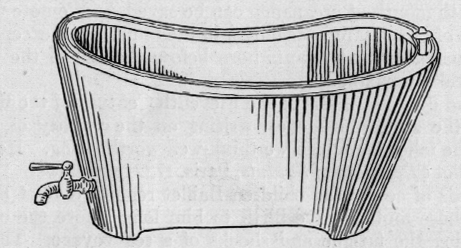
Above: Dr. Jean-Louis-Paul Denucé’s incubator for premature infants, Bordeaux, ca. 1857. Essentially a double-walled tub, separated by a closed space that can be filled with warm water. This is the first known reference to an incubator in the Western medical literature.
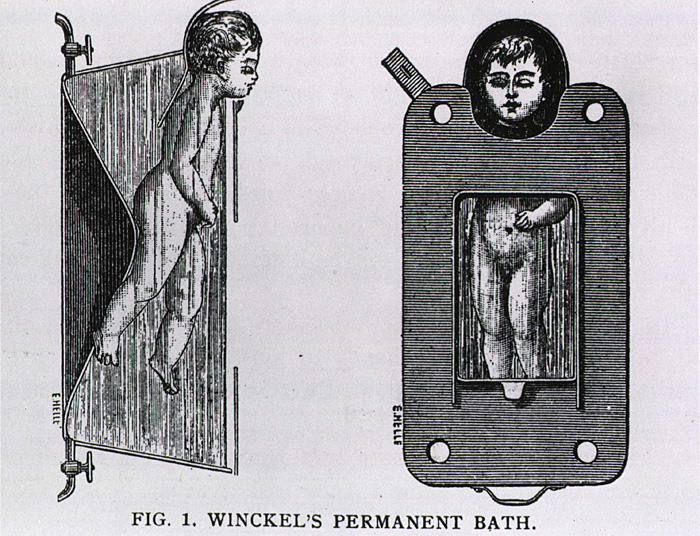
Above: Franz Winckel’s “Permanent Bath for Newborns,” Dresden, 1882
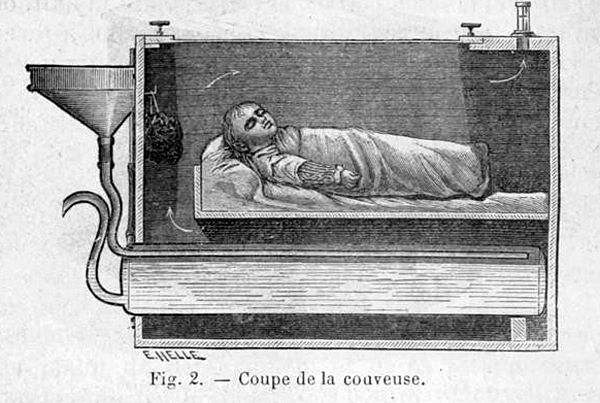
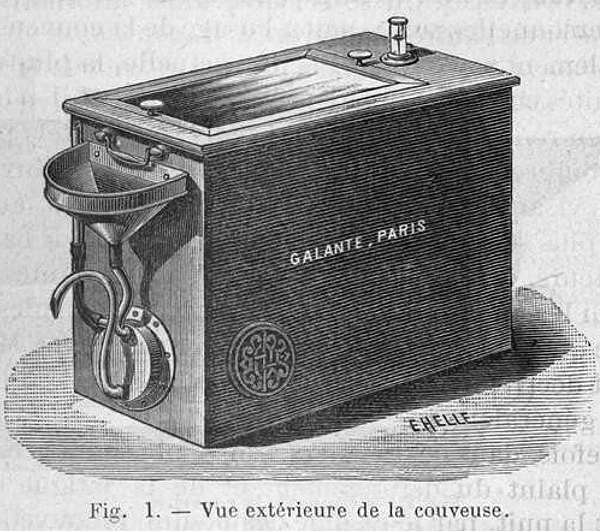
Above: Dr. Stéphane Tarnier’s first incubator came into regular use at the Maternité of Port Royal in Paris in 1881. The lower half was occupied by a large tank of hot water.


Above: Dr. Carl Siegmund Franz Credé published a description of his “warming tub” in 1884, which appears very similar to Denucé’s and Winkel’s incubators. He stated that it had been in regular use since 1866 in the Leipzig maternity hospital and included survival statistics.
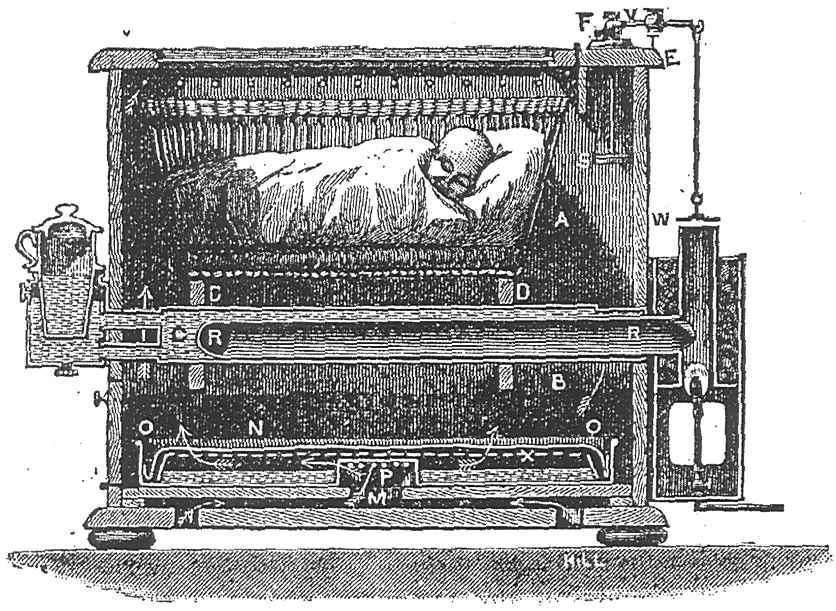
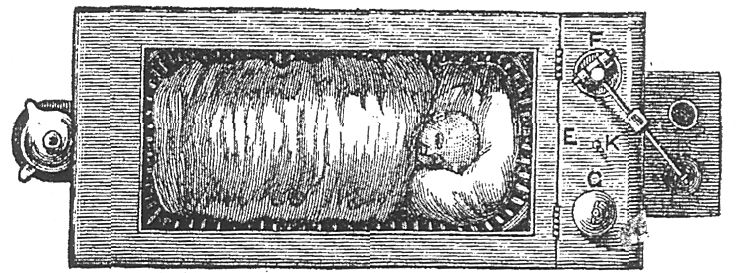
Above: Eustache’s paper of 1885 described Tarnier’s efforts and went on to describe his own model of incubator, built by Hearson of London. He said it was in use in Brusells and London.
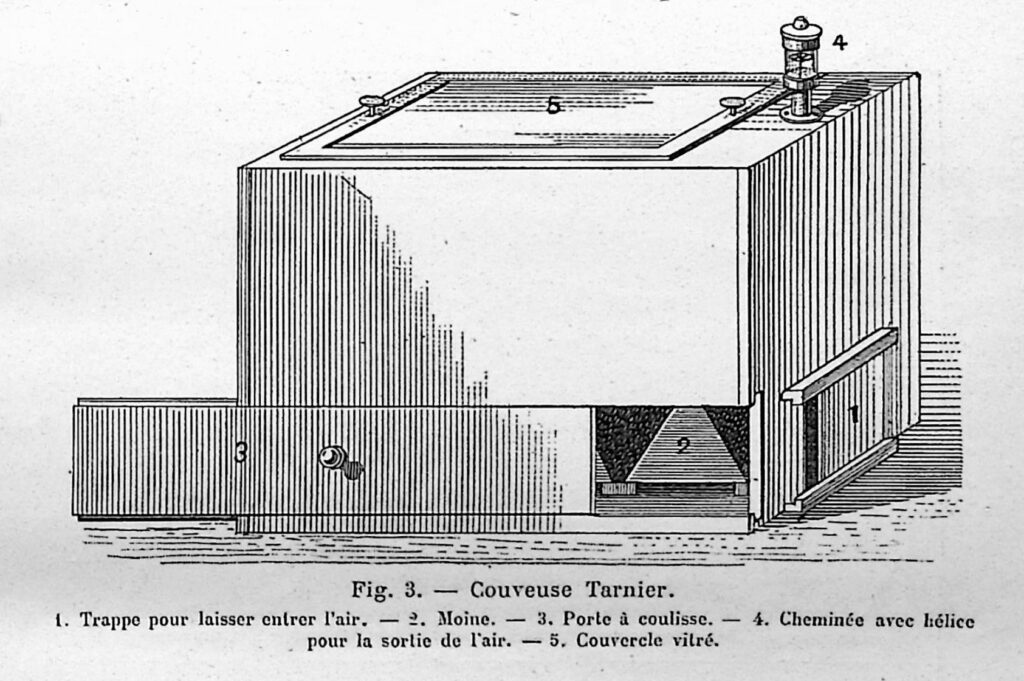
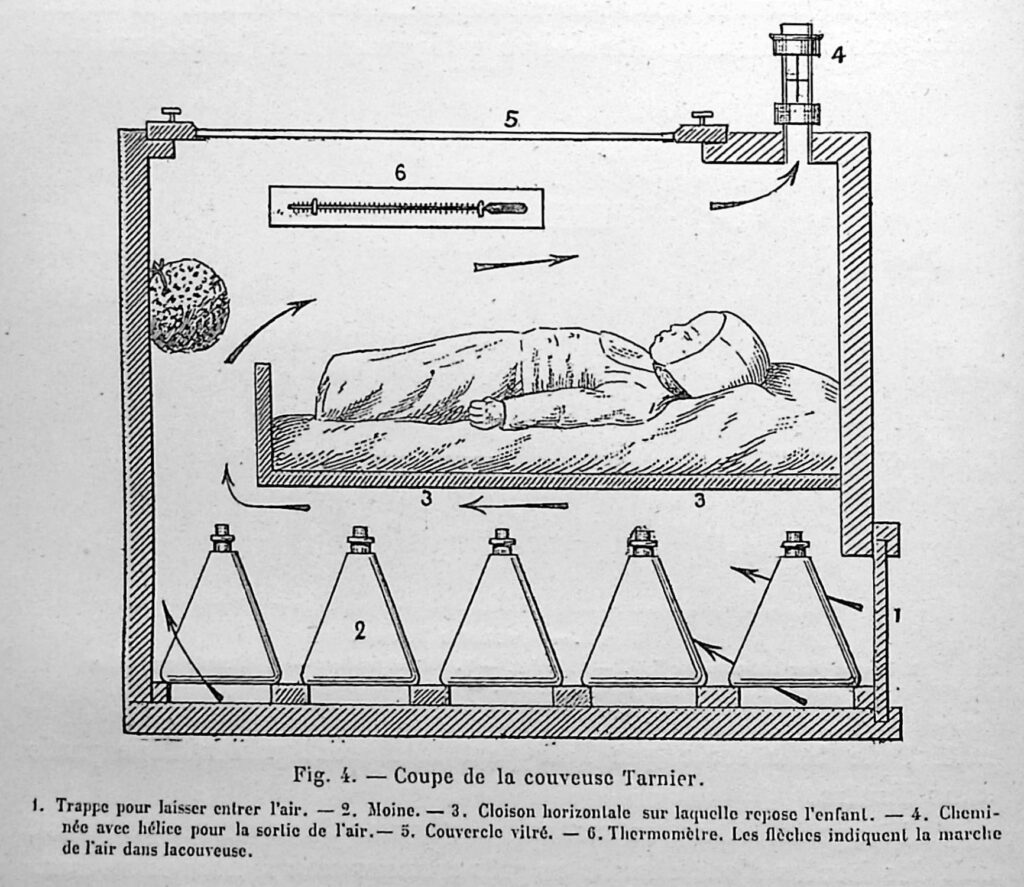
Above: Dr. Stéphane Tarnier’s and Dr. A. Auvard’s new and improved incubator design (“nouvelle couveuse”) came into use at the Maternité of Port Royal in Paris around 1884. The small tanks of hot water in the bottom section could easily be replaced as needed through a sliding door to keep the incubator section warm.
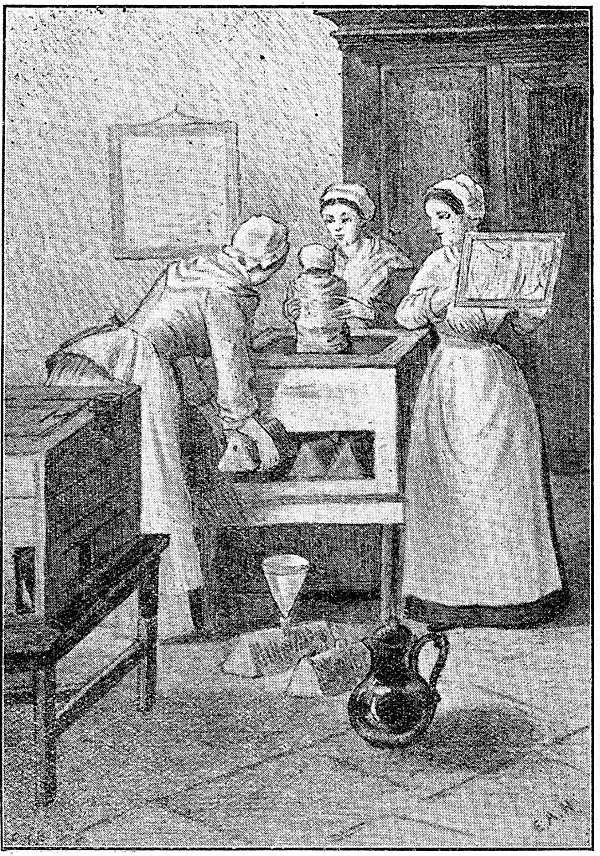
Above: Tarnier incubator in use at the Maternite, Paris.
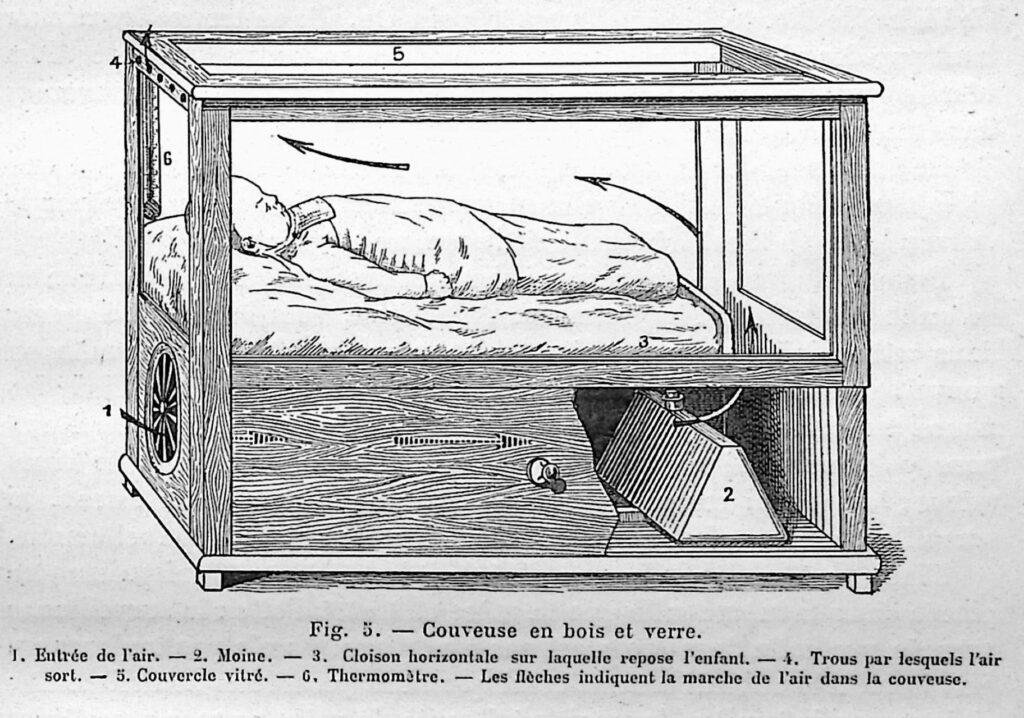
Above: By 1900, the Maternité was in the charge of Pierre Budin and was using an improved version of Tarnier’s incubator that had glass sides for easier observation of the infant.
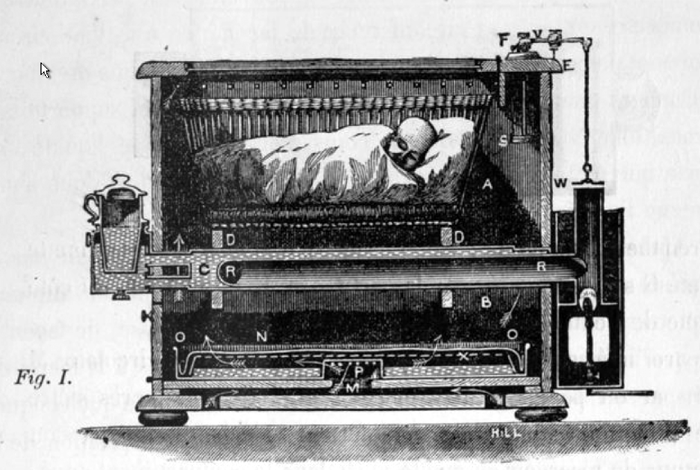
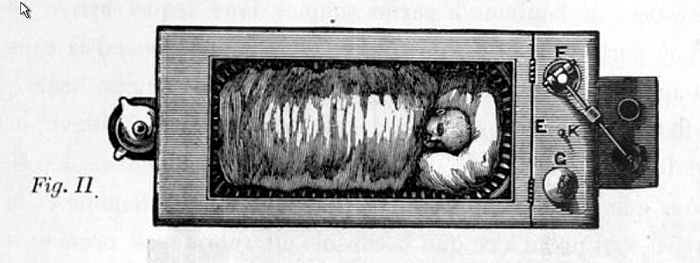
Above: Incubator used by G. Eustache of Lille, France. It was constructed by Hearson in London under his direction, derived from their Champion incubator for poultry, and marketed as “Hearson’s Thermostatic Nurse.” He was aware of Tarnier’s incubator and talks about it in his paper, many features are similar.
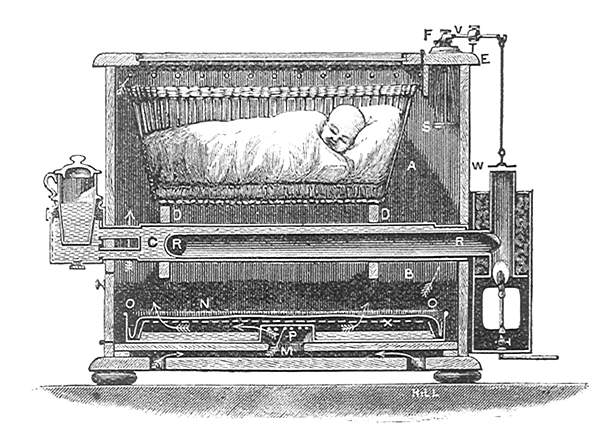
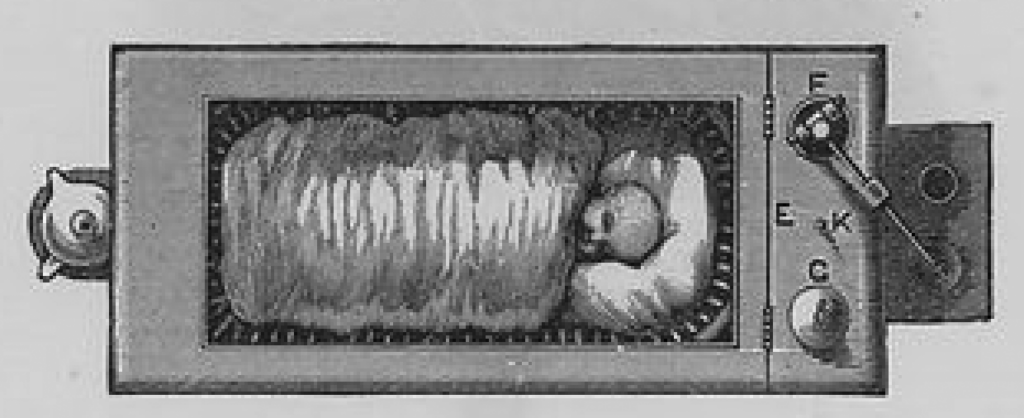
Above: Hearson’s Thermostatic Nurse, ca. 1884, constructed by Hearson in London under direction of G. Eustache of Lille, France, as advertised and used in England.
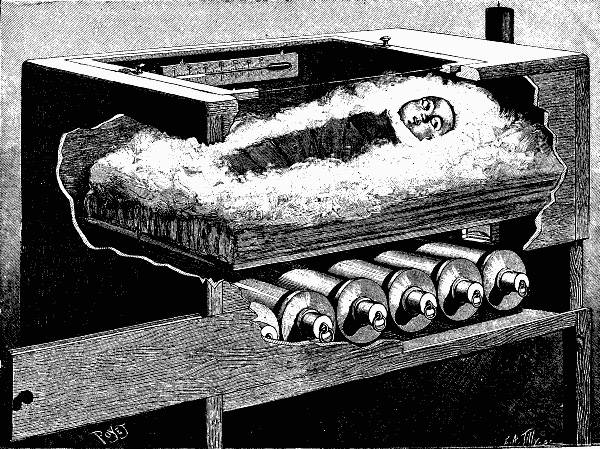
Above: A diagram of an incubator that appeared in the Scientific American Supplement in 1888. No explicit attribution in the article but Tarnier and Budin in Paris are mentioned in the text.
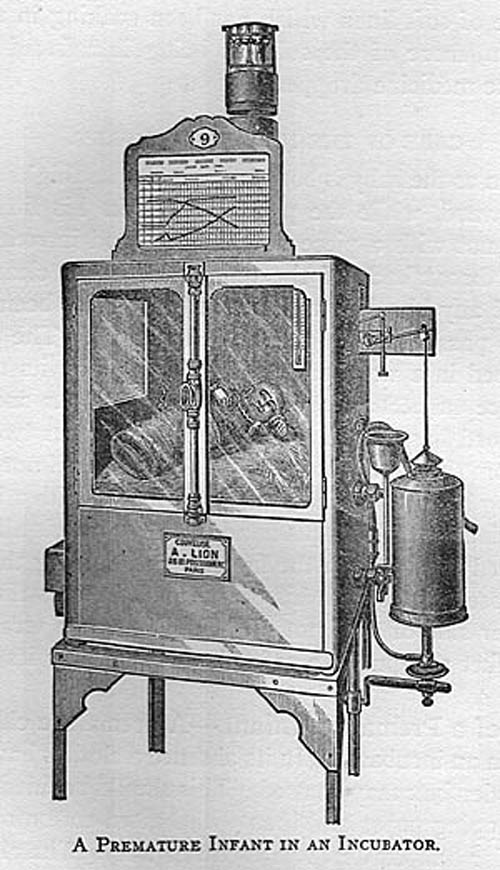
Above: Dr. Alexandre Lion’s incubator, patented in 1889 and used in his own establishments throughout France as well as in the incubator sideshows at many international exhibitions.
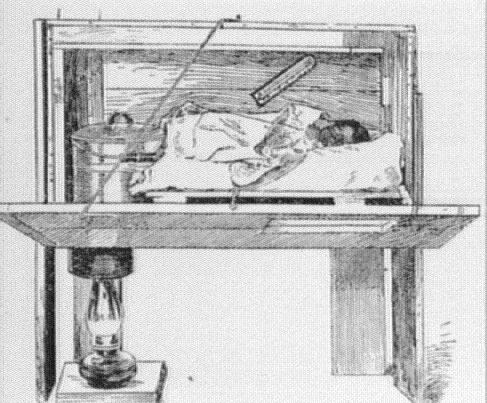
Above: An incubator improvised by a Minneapolis doctor ca. 1892 for a premature delivery.
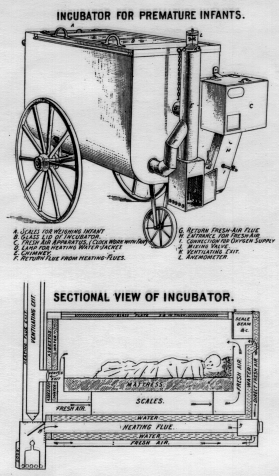
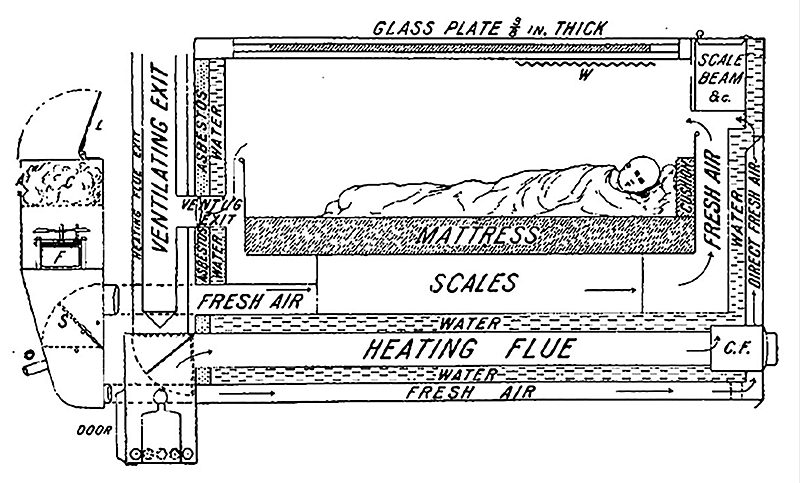
Above: Incubator described by Dr. T. M. Rotch in 1893, Boston.
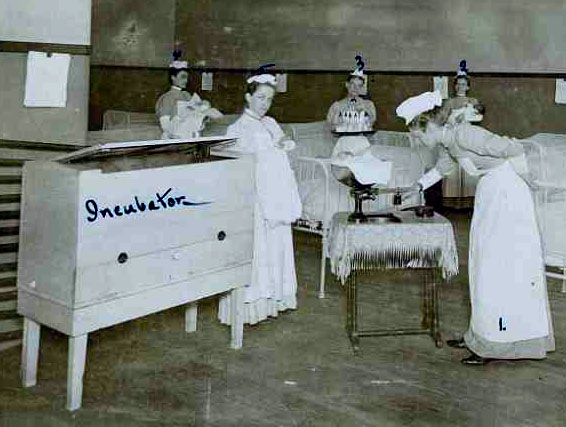
Above: Nurses caring for newborns at Philadelphia General Hospital in 1895. Primitive incubator visible at the left.
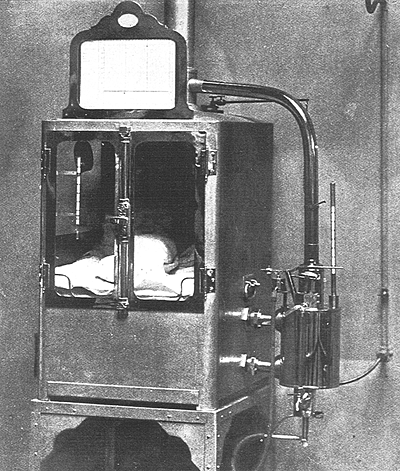
Incubator manufactured by Paul Altmann in Berlin ca. 1897, adapted from the design of Dr. Alexandre Lion.
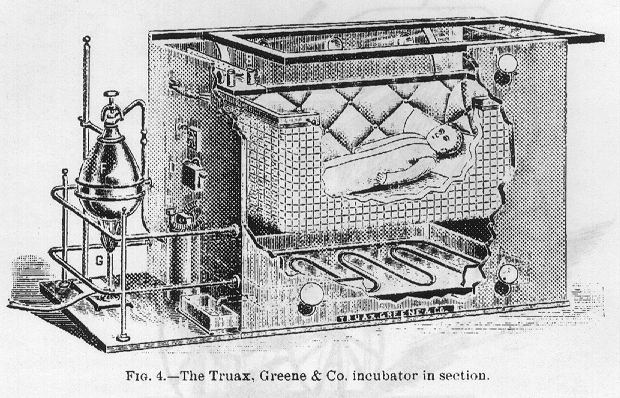
Incubator manufactured by Truax, Greene and Co. referenced in a paper by Dr John A. Lyons, Chicago, 1897.
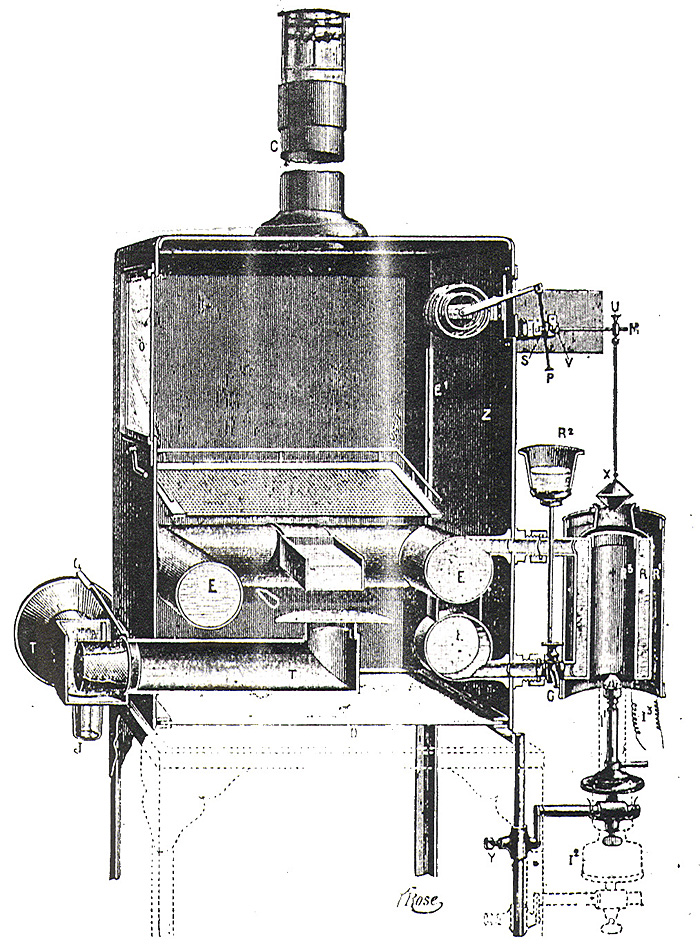
Above: Incubator illustrated in “The Artificial Incubator for Infants” by V. Pascaud in 1899, Paris. Seems to be the Lion incubator.
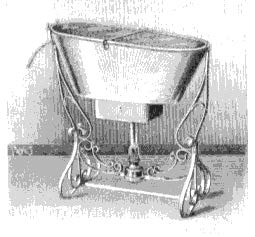
Above: Léon Diffre’s couveuse ca. 1898.
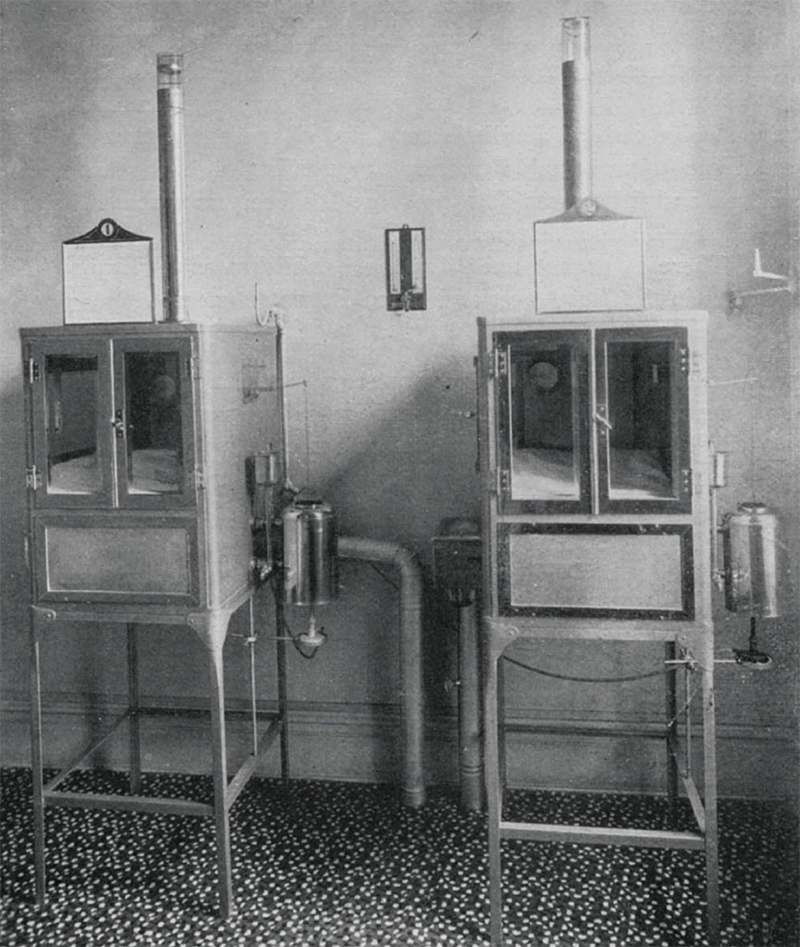
Above: Incubators at the Chicago Lying-In Hospital ca. 1900. Evidently based on the Lion design. Source: Northwestern Memorial Hospital Archives.
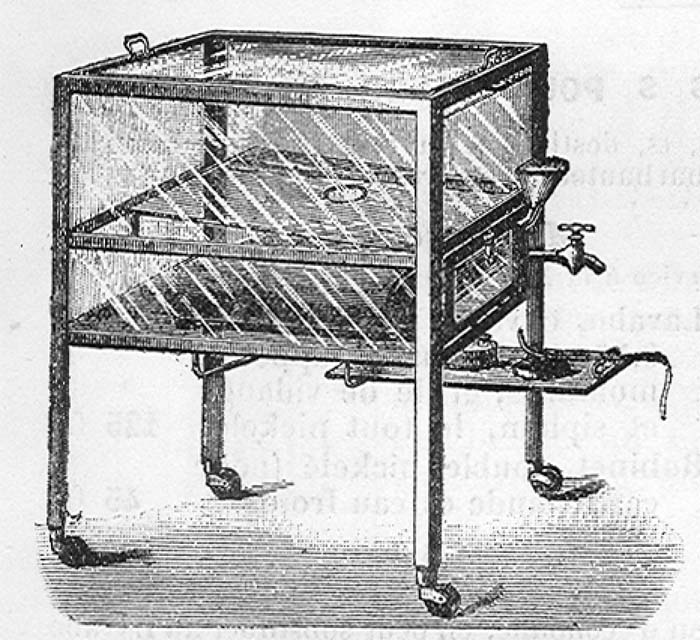
Above: “Couveuse en Glace” found in the 1900 operating room equipment catalog of Flicoteaux, Borne, and Boutet, Paris.
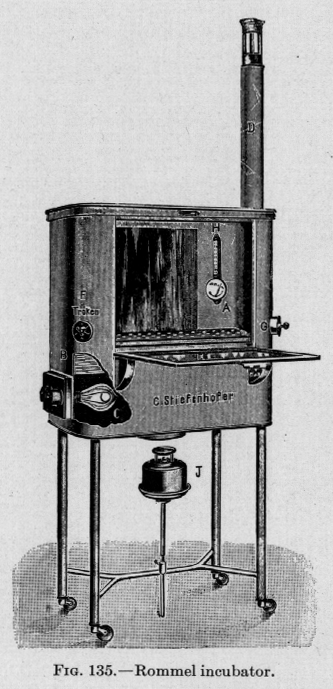
Rommel incubator ca. 1900. Source: Julius Hess, “Premature and Congenitally Diseased Infants.”
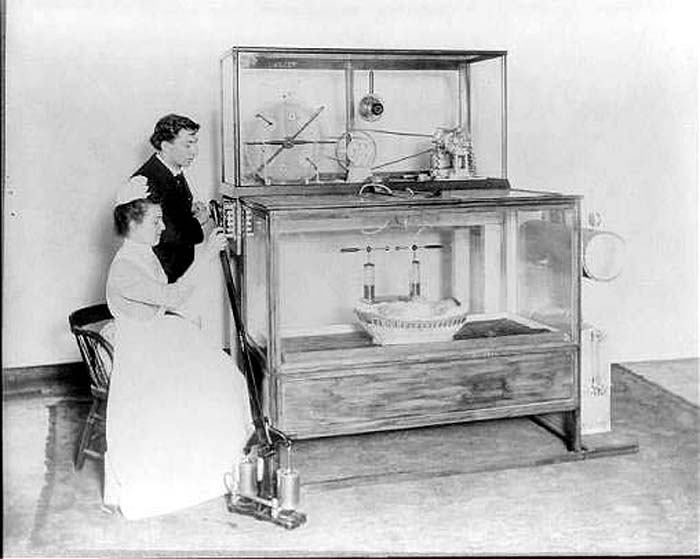
Above: Dr. How’s Electric Incubator, 1903. (This picture is available from several sources, but I have not been able to find any other information about the incubator or Dr. How. If you run across something that will shed more light on this incubator’s history, please email webmaster@neonatology.net.)
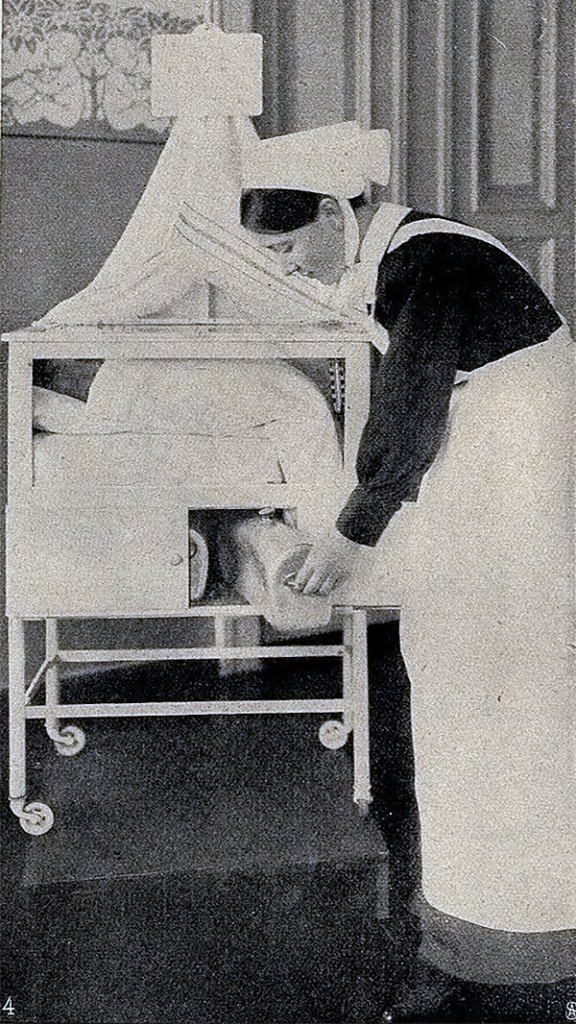
Above: Nurse changing the warm water bottles on an incubator of the Tarnier/Auvard/Budin design, at a newly opened “baby home” (säulingsheim) in Schöneberg near Berlin, 1904.
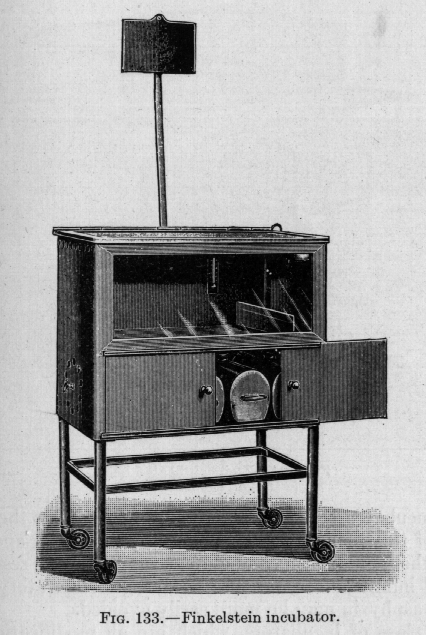
Finkelstein incubator ca. 1905. Source: Julius Hess, “Premature and Congenitally Diseased Infants.”
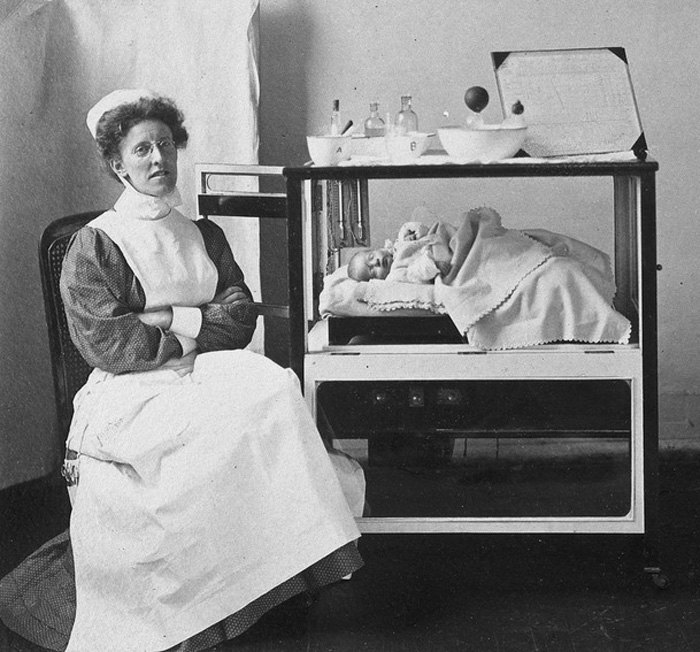
Above: Nurse sitting with incubator at the General Lying In Hospital, Lambeth, England, 1908.
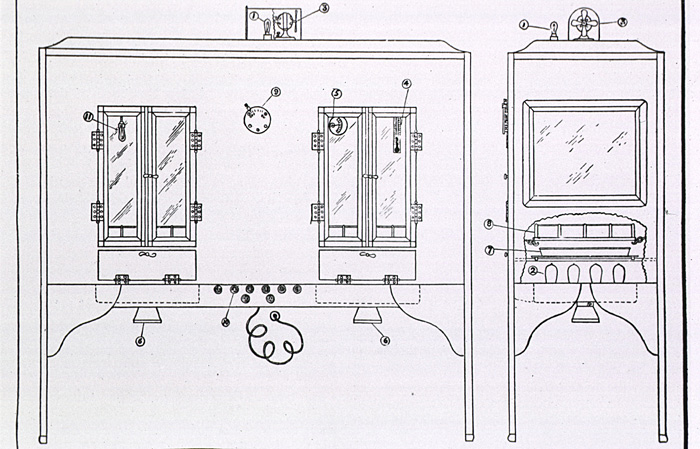
Above: Incubator used at the Sloane Hospital for Women, New York City, 1914, as seen in JAMA Volume 63 No. 11.

Above: Baby in a warm water incubator, Rotterdam School for Midwives, 1914.
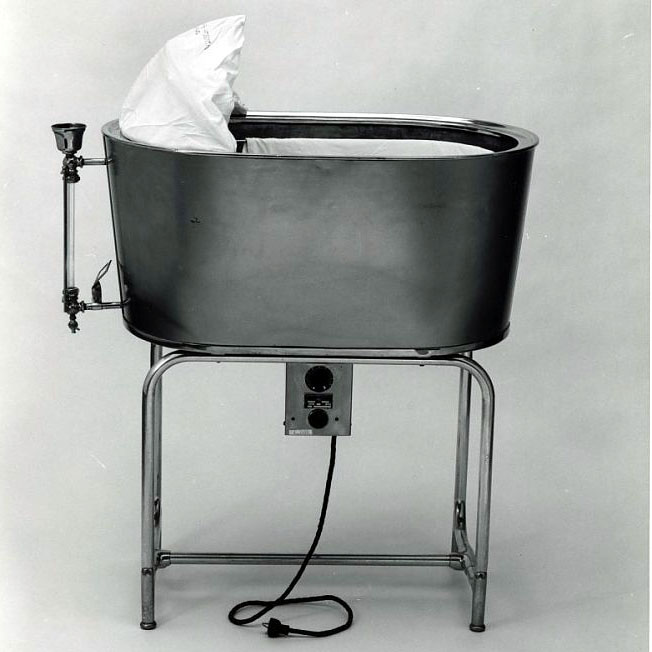
Above: Dr. Julius Hess’s open bed warming incubator, Chicago, Illinois, in use at the Premature Infant Station at Sarah Morris Hospital ca. 1915. Photo from the National Museum of American History.
1920s, 1930s, and 1940s
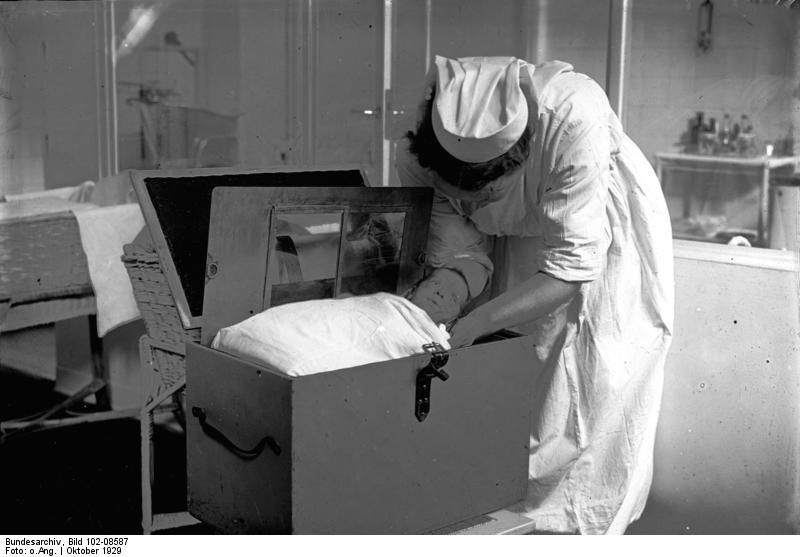
Above; Portable incubator at the Kaiserin Augusta Victoria Hospital in Berlin. Bundesarchiv copy is dated 1929, however, the same photo appeared on the cover of l’Informateur Medical on October 11, 1925.
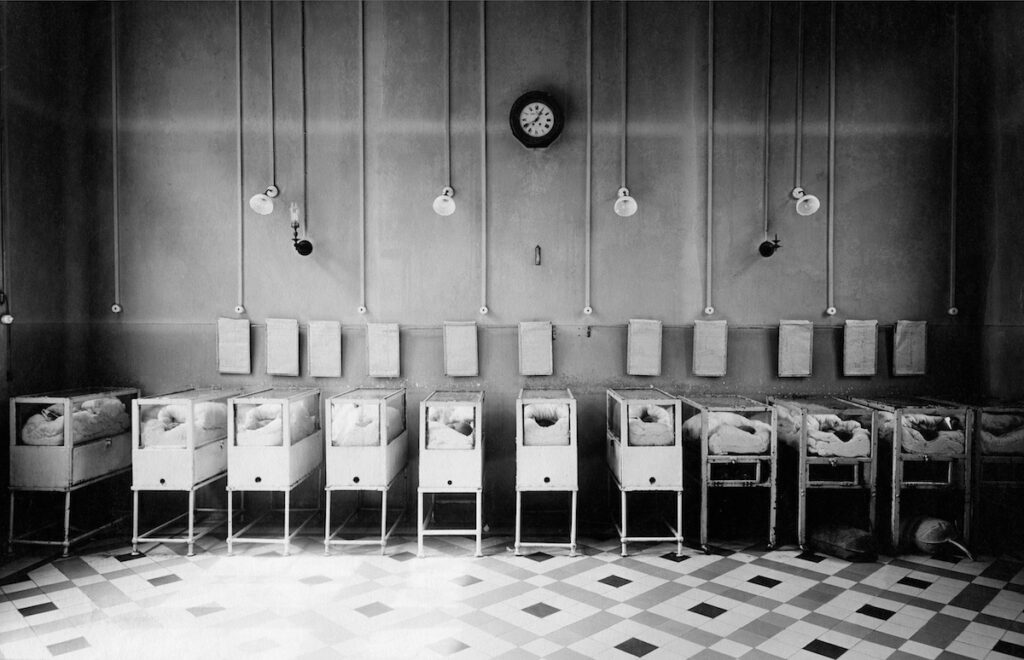
Above: Incubators at the Bonnaire Hospital in Paris ca. 1928.
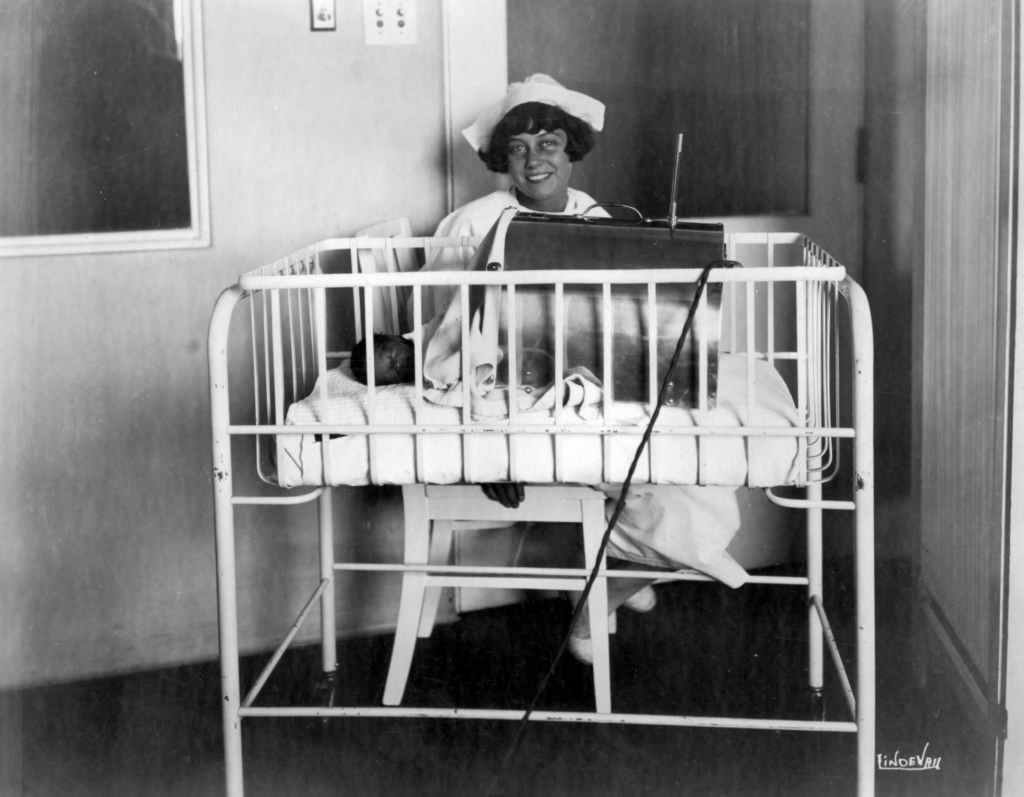
Incubator in use at Denver Children’s Hospital, 1920s.
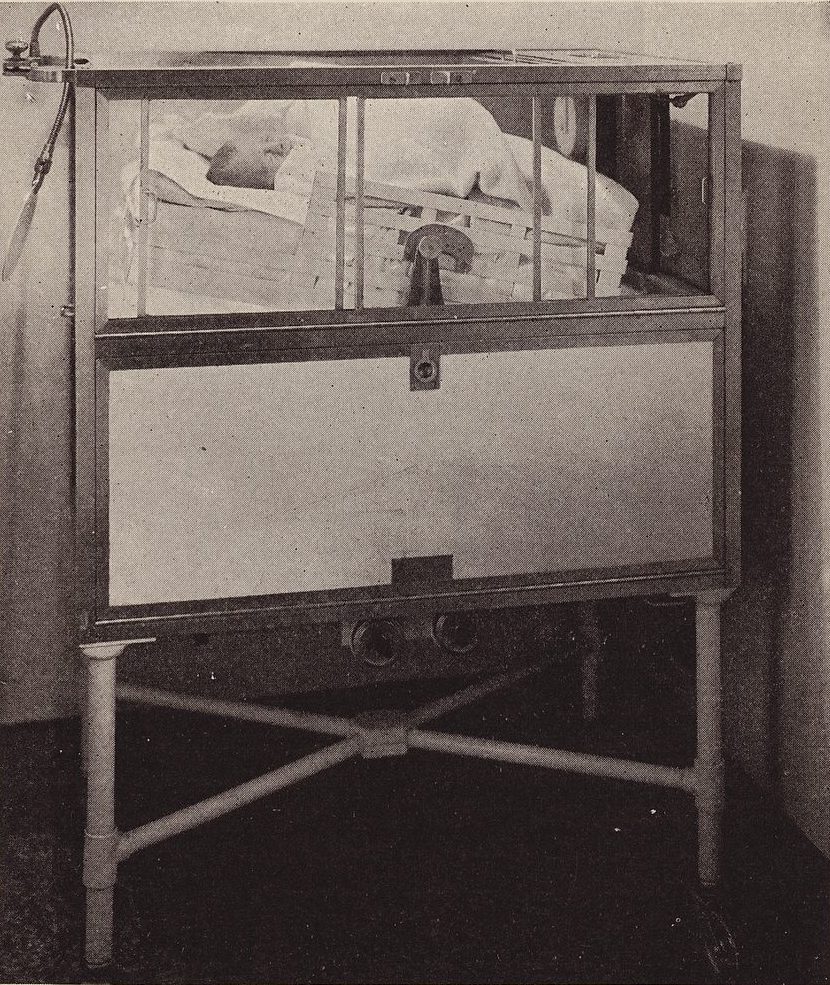
Above: Morganthaeler incubator for premature babies. Source: Nurses Handbook of Obstetrics, JB Lippincott Co., 1929.
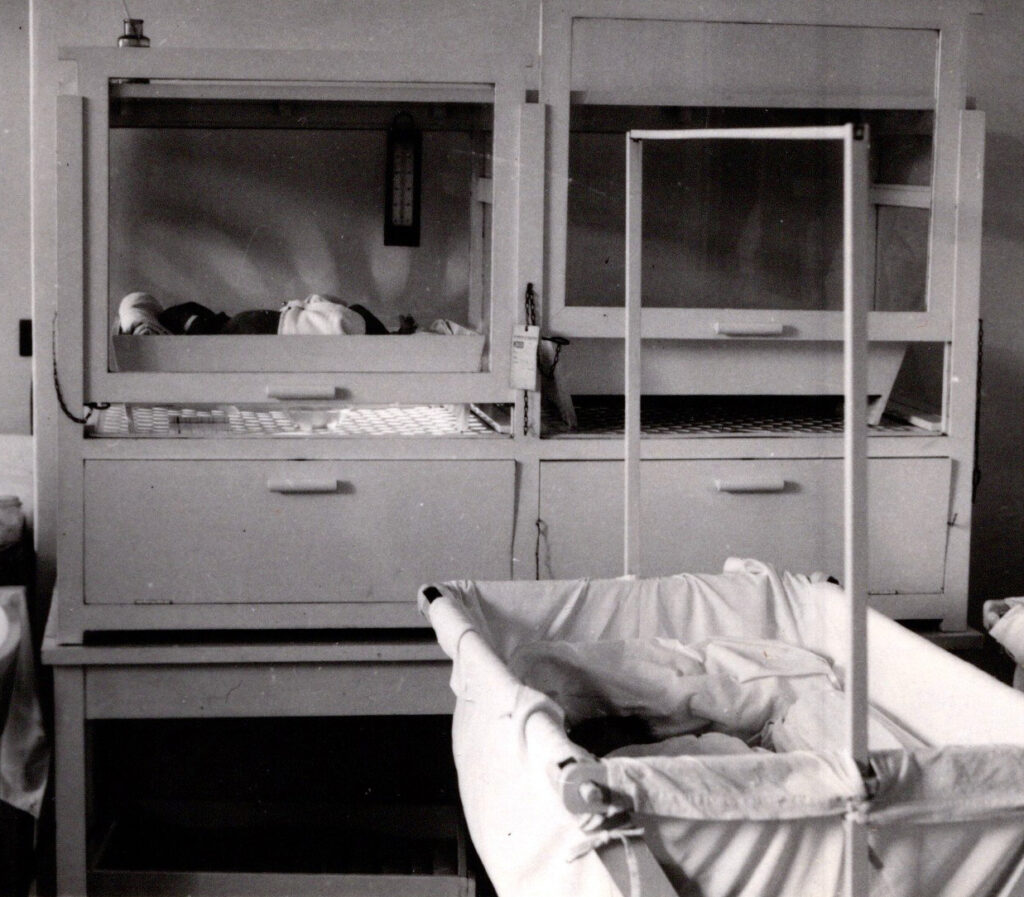
Above: Couveuse early 1930s in France. Photo is undated and location is unclear but may be at L’Hôpital des Enfants-Malades, Paris.
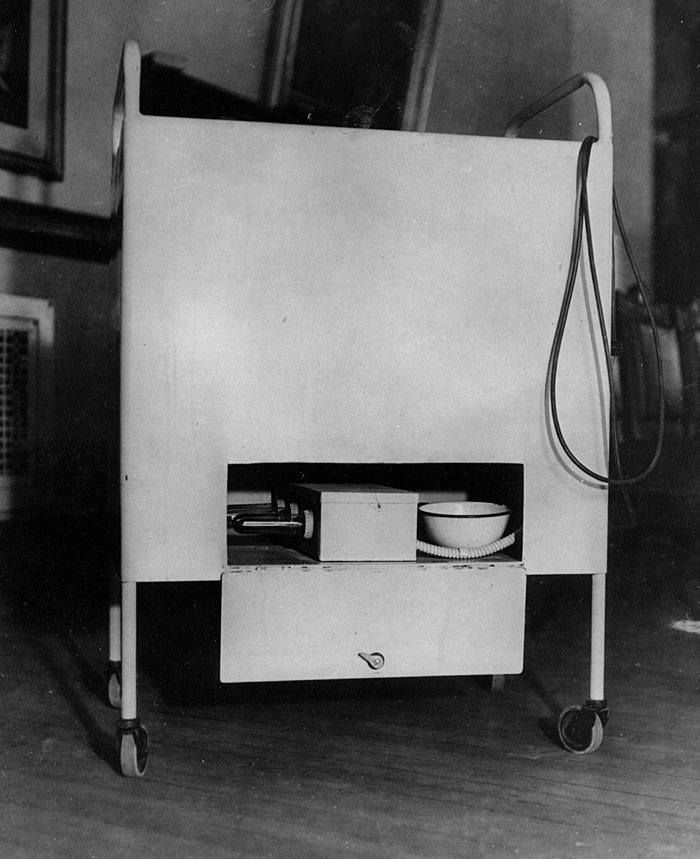
Above: Hotbed incubator developed at the Pennsylvania Hospital in Philadelphia, 1933. Photo from ACME Newspictures.
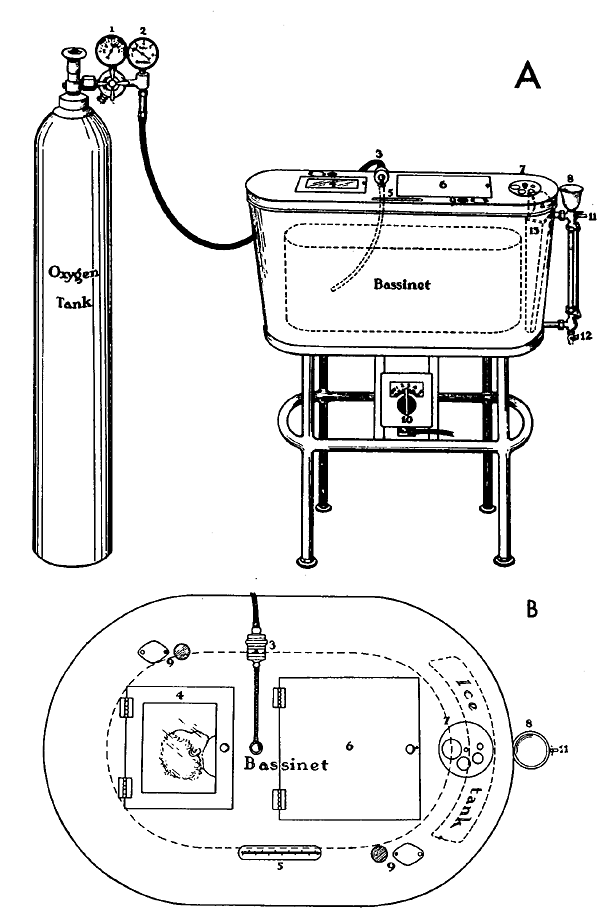
Above: Around 1934, Dr. Julius Hess changed his incubators from an open-bed to closed-bed design, so that oxygen could be administered. These incubators were in use at the Sarah Morris Children’s Hospital in Chicago. The usual practice at that time was to maintain infants in 40% oxygen if they needed supplementation. 1.-Pressure gauge, 2.–oxygen flow regulator, 3.-flow meter 4.-glass and metal hinged door for feeding purposes, 5.-thermometer window, 6.-metal hinged door for purposes of body care of the infant, 7.-ventilator with small and large exit openings, 8- 12. – controls for maintaining temperature in water-jacket of the incubator.
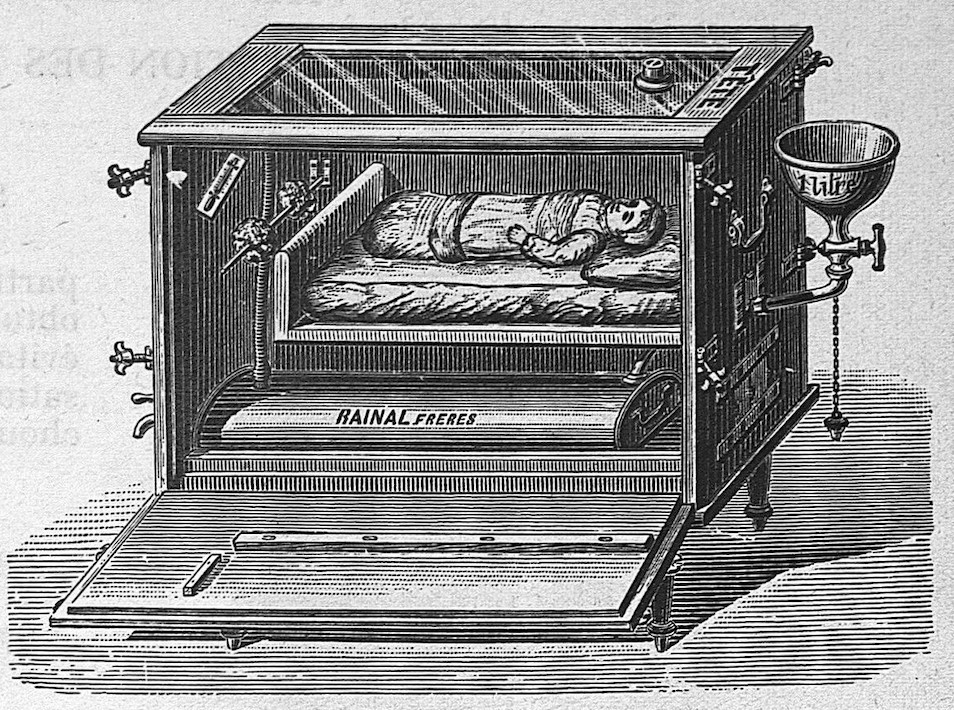
Above: “Couveuse Aspetique” from the industrial catalog of Rainal Frères, Paris, 1934. Source: Bibliothèque numérique Medica, Université Paris Cité.
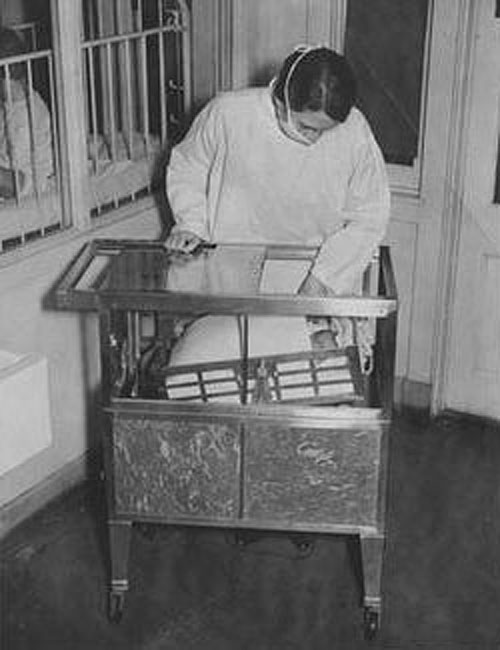
Above: Baby in a “rocking” incubator ca. 1936. Babies’ Hospital, Philadelphia. Photo from Philadelphia Historical Digital Image Library.

Above: Incubators at the Maternity Hospital, Lausanne, Switzerland, ca. 1937. Associated Press photo.
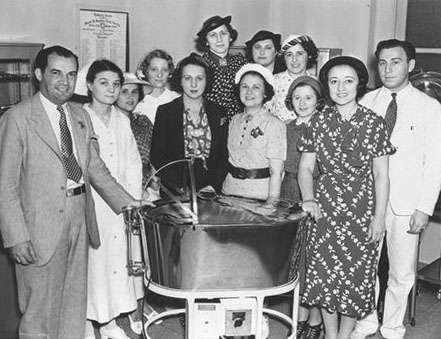
Above: Presentation of an incubator for the nursery of the Northern Liberties Hospital, June 14, 1937. Photo from Philadelphia Historical Digital Image Library.
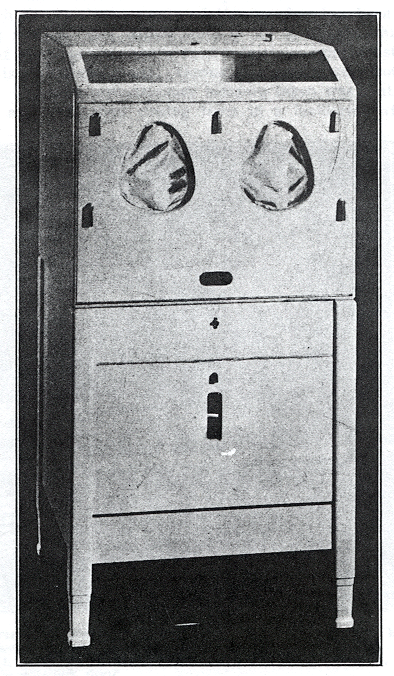
Above: Exterior of the Chapple Incubator, Philadelphia, Pennsylvania, 1938. Novel features included rolled sleeves, water gauge, improved control of temperature and humidity, and lighted interior. Source: Charles C. Chapple, American Journal of Obstetrics and Gynecology, p. 1064, 1938.

Above: Interior of the Chapple Incubator, Philadelphia, Pennsylvania, 1938. Source: Charles C. Chapple, American Journal of Obstetrics and Gynecology, p. 1064, 1938.
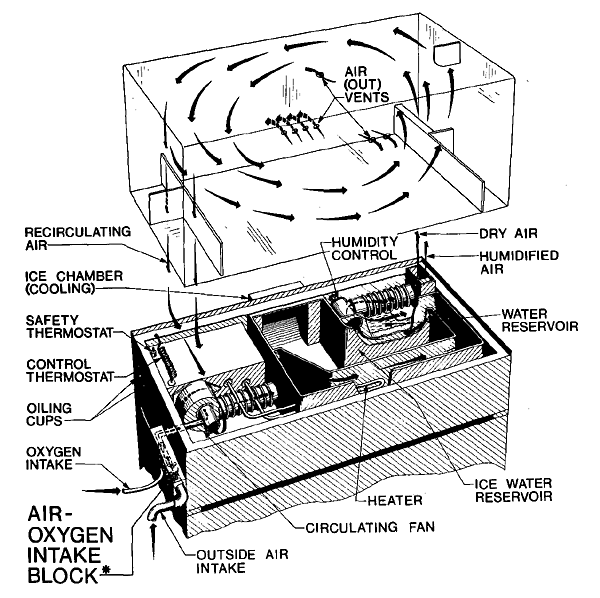
A pre-1954 individually ventilated Chapple-type incubator (blow-up view). Air was drawn into the incubator at the rate of 10 liters per minute to prevent the accumulation of carbon dioxide produced by the infant occupant and to bar the entrance of nursery air when the access ports were opened to care for the infant. The plexiglass hood made the respiratory movements of the naked infant in the incubator highly visible to attendants. See details of air-oxygen intake block below. Source: “Retrolental Fibroplasia: A Modern Parable” by William A. Silverman.
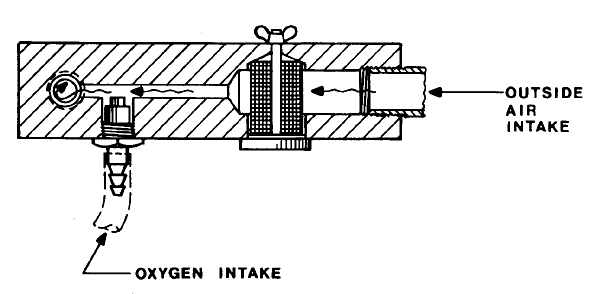
Air-oxygen intake assembly of the pre-1954 model Chapple-type Isolette incubator. A two-tiered float valve was raised by the flow of oxygen to restrict the flow of diluting outside air into the incubator. Source: “Retrolental Fibroplasia: A Modern Parable” by William A. Silverman.

Above: 17-ounce baby in Dayton incubator, 1939. Photo from N.E.A.
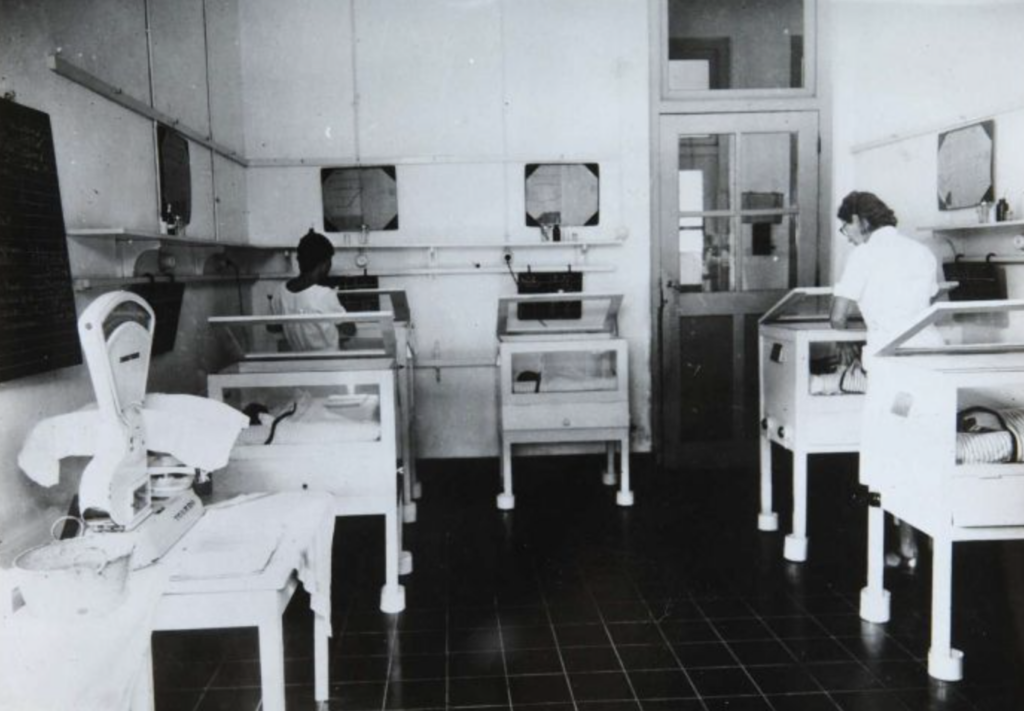
Above: Incubators in Jakarta, 1939.
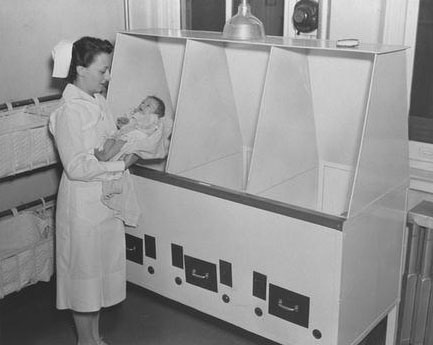
Above: Nurse with incubators at the Kensington Hospital for Women, ca. 1940. Photo from Philadelphia Historical Digital Image Library.
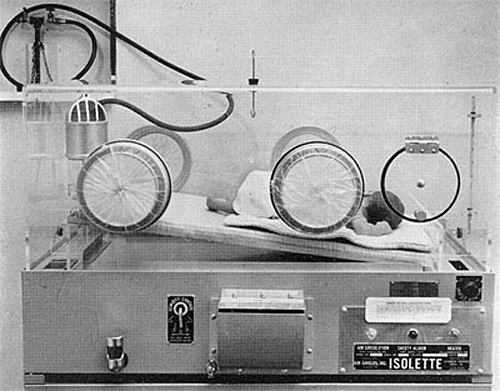
An isolette in use around 1940. These sturdy but primitive incubators remained in use in many nurseries until the 1960s and 1970s. I remember seeing them when I was a medical student.
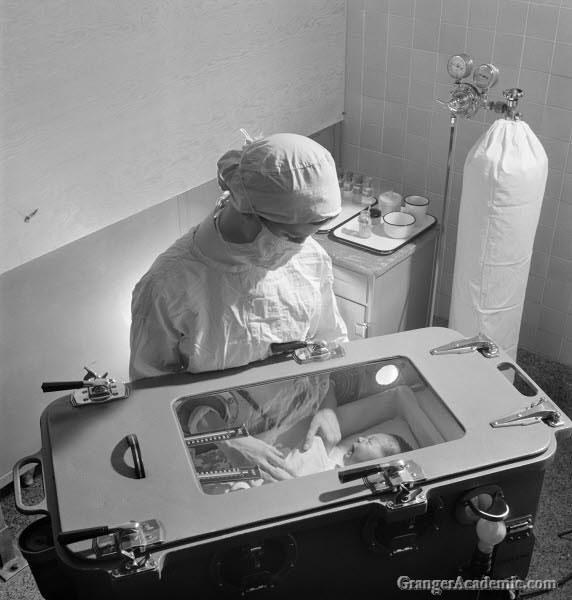
Above: Nurse caring for premature infant in an incubator. Photo by Fritz Henle, 1942. From the Granger Academic Educational Picture Archive.
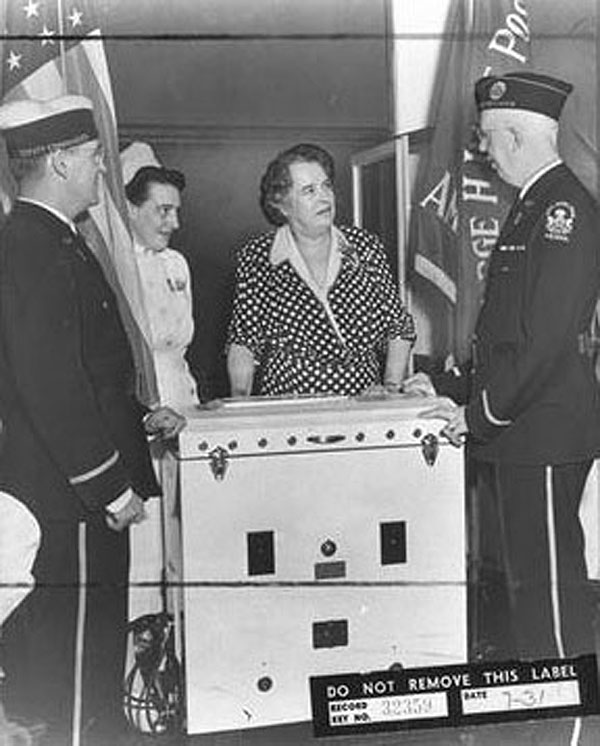
Above: American Legion gift of an infant incubator to the Women’s Southern Homeopathic Hospital, ca. 1942. Photo from Philadelphia Historical Digital Image Library.
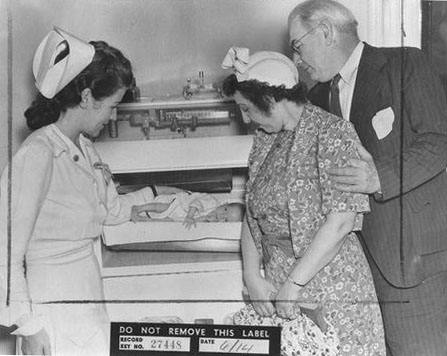
Above: Infant occupation of a newly developed incubator at Doctor’s Hospital, 1942. Photo from Philadelphia Historical Digital Image Library.

Above: The Charlotte Box, built by Oxygenaire Limited of London, used in England 1945-1955. Image from the Wellcome Image Collection.
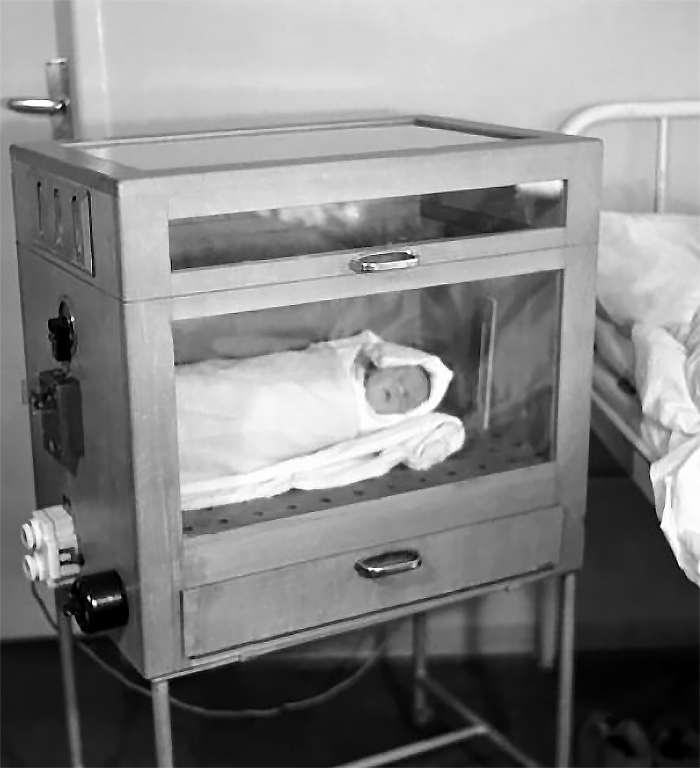
Above: Czech incubator ca. 1947.
1950s and 1960s
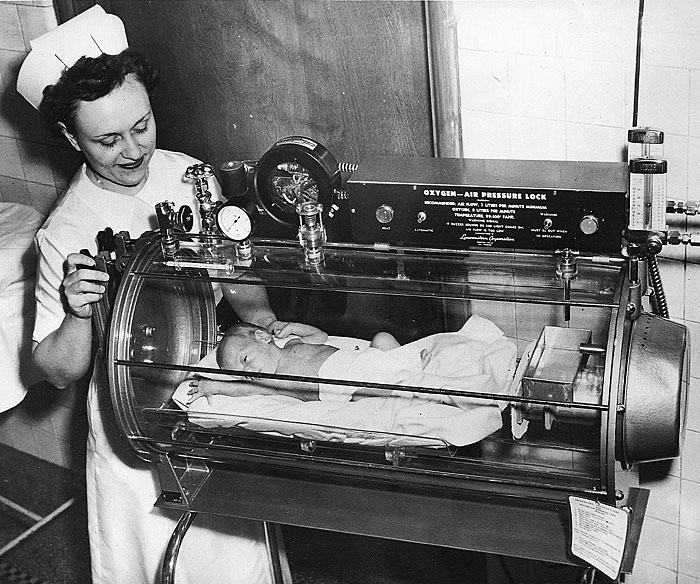
Above: Incubator at DePaul Hospital, St. Louis, Missouri, in 1950.
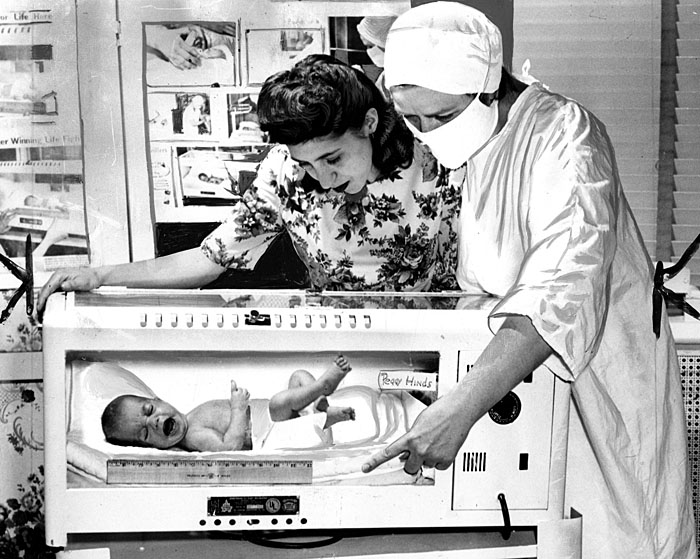
Above: Mom and nurse look at premature baby in incubator, 1950. International News Photos.
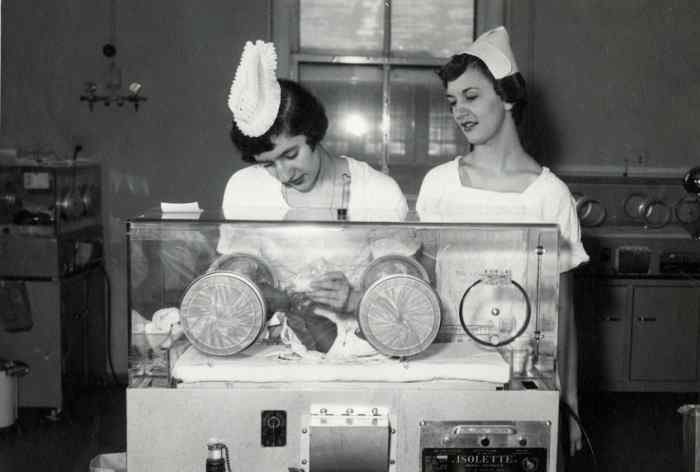
Above: Nurses caring for a premature infant at Philadelphia General Hospital, 1950.
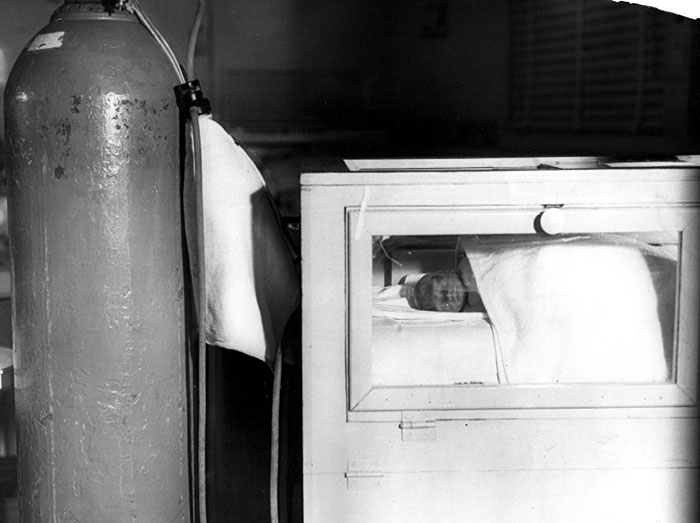
Above: One day old premature baby in a Kansas incubator, 1954. N.E.A. photo.
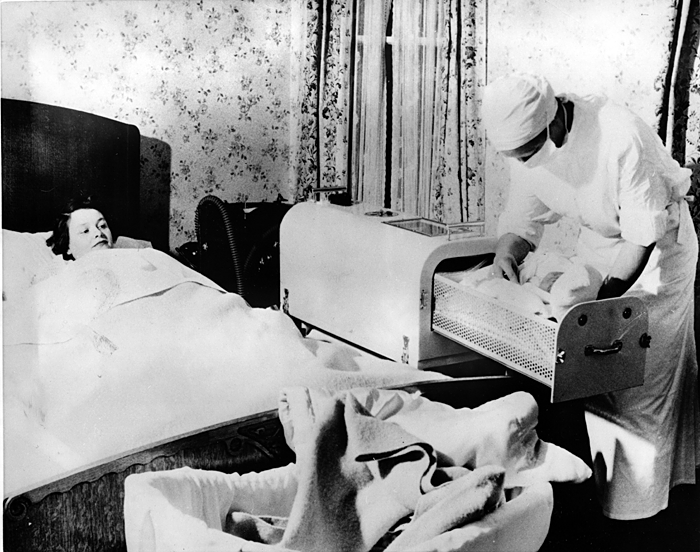
Above: British-designed “Mechanical Mother” incubator, 1954. United Press photo.
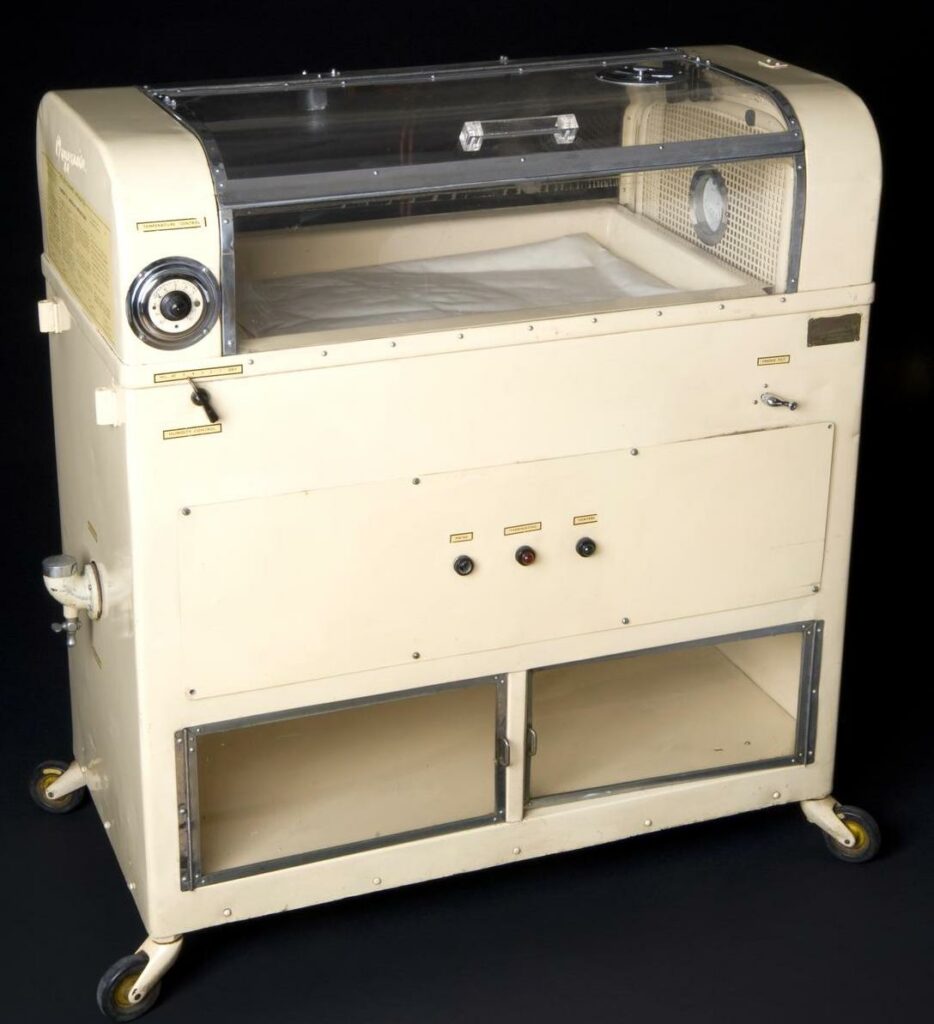
Above: Incubator manufactured by Oxygenaire Ltd., London, 1955.
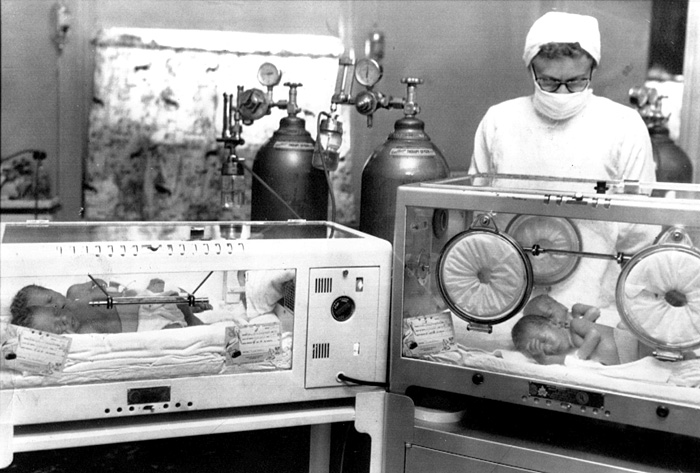
Above: Quads in incubators, Sandston, Virginia, 1958. Photo from UPI.
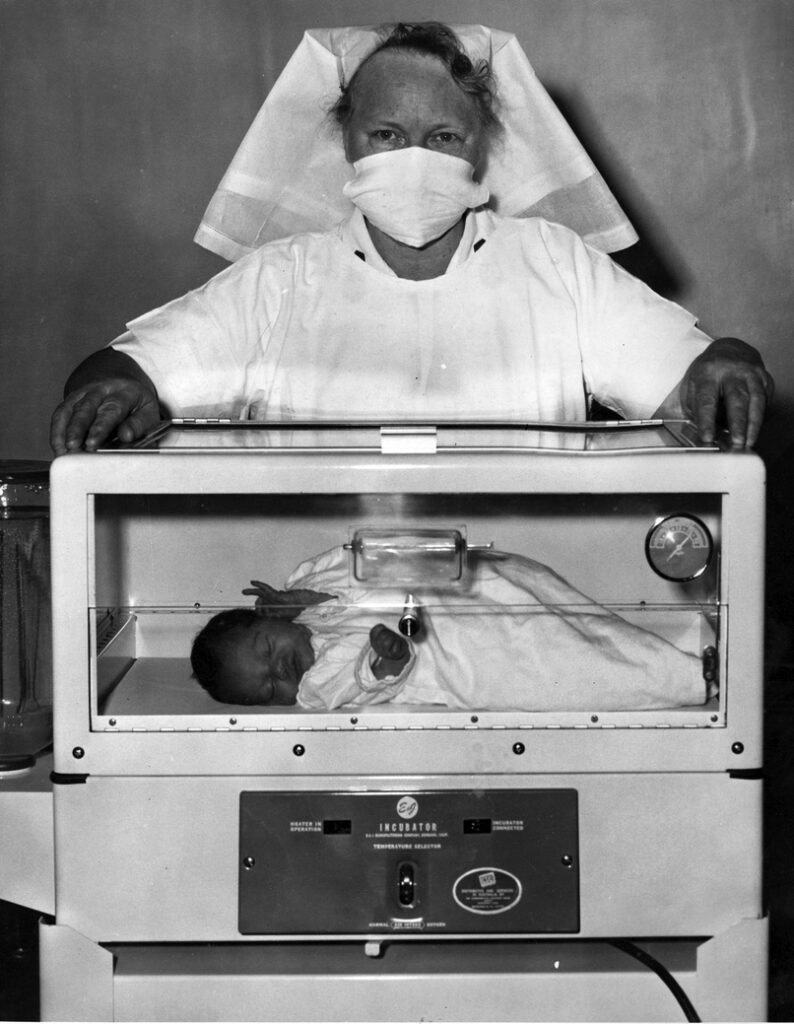
Above: Incubator at the Bethany Maternity Hospital, Papanui, 1963.
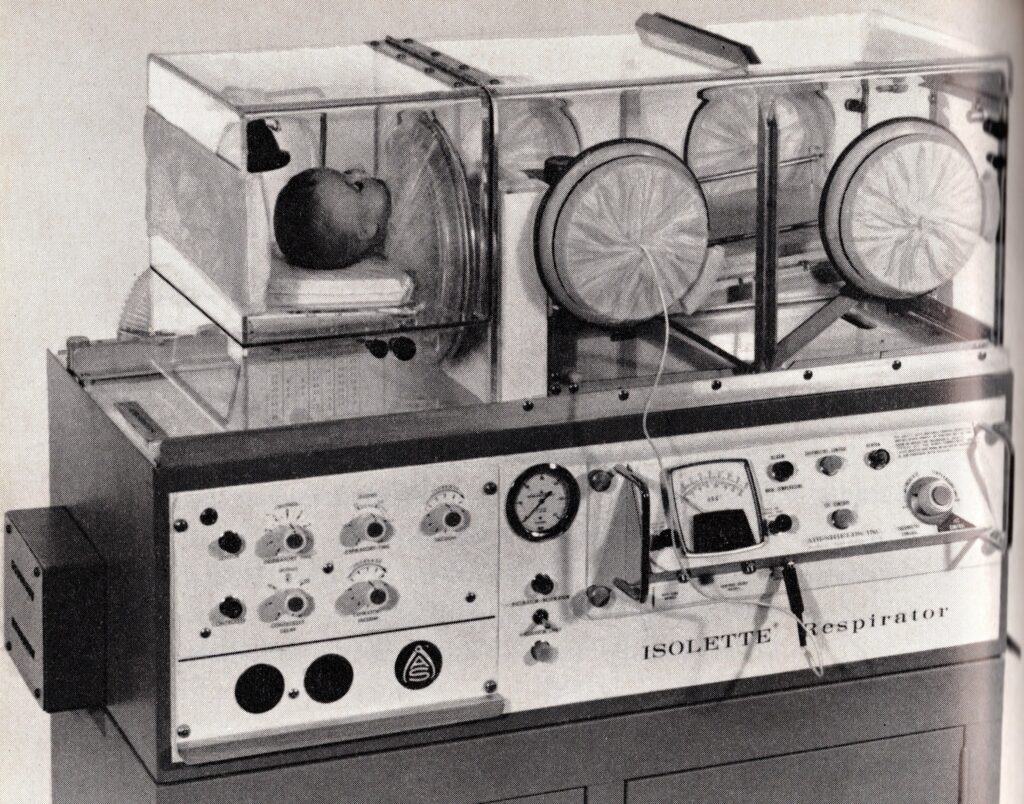
Above: Air Shields announced this combination incubator/respirator in 1965 at the International Pediatrics Conference in Tokyo. It had separate compartments for the head and body, separated by a soft neck and shoulder cuff. Oxygen could be supplied to the head compartment, while negative pressure was applied to the body compartment. Negative pressure, inhalation time, and I/E ratio could all be separately controlled, and a patient-driven assist mode could also be used that used a thermocouple sensor in a face mask. An engineering landmark at the time, these were rapidly outmoded by the positive-pressure, time-cycled neonatal ventilators that appeared in the 1970s, such as the Baby Bird and the Bournes BP-200.
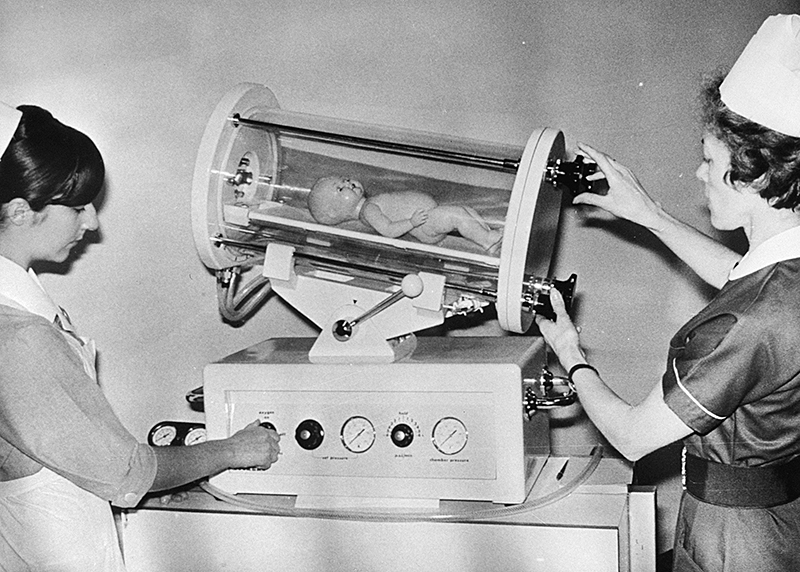
Above: Nurses learning to use an incubator in Oostenrijk, Netherlands, 1966. Source: Nationaal Archief.
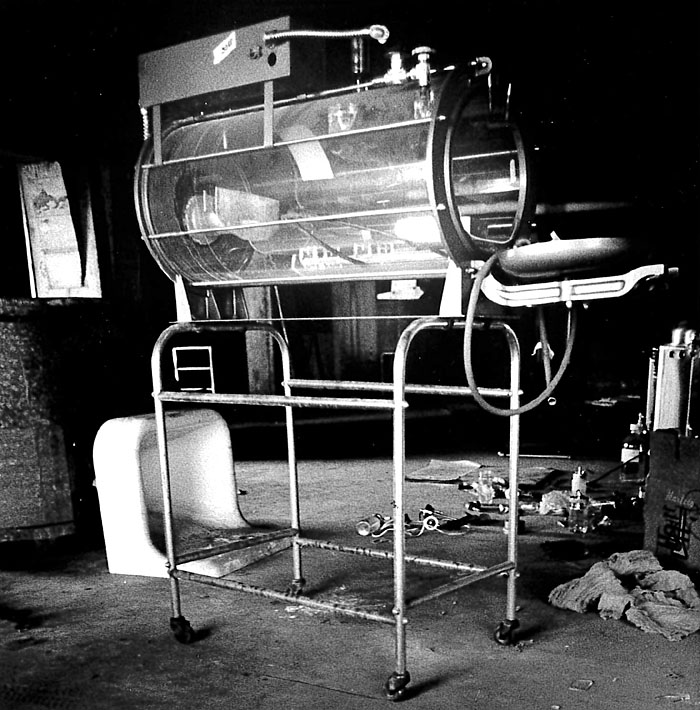
“Ancient” incubator found at St. Vincent’s Hospital, Portland, Oregon, as it was being torn down in 1974. Photo originally published in The Oregonian.
Modern Incubators
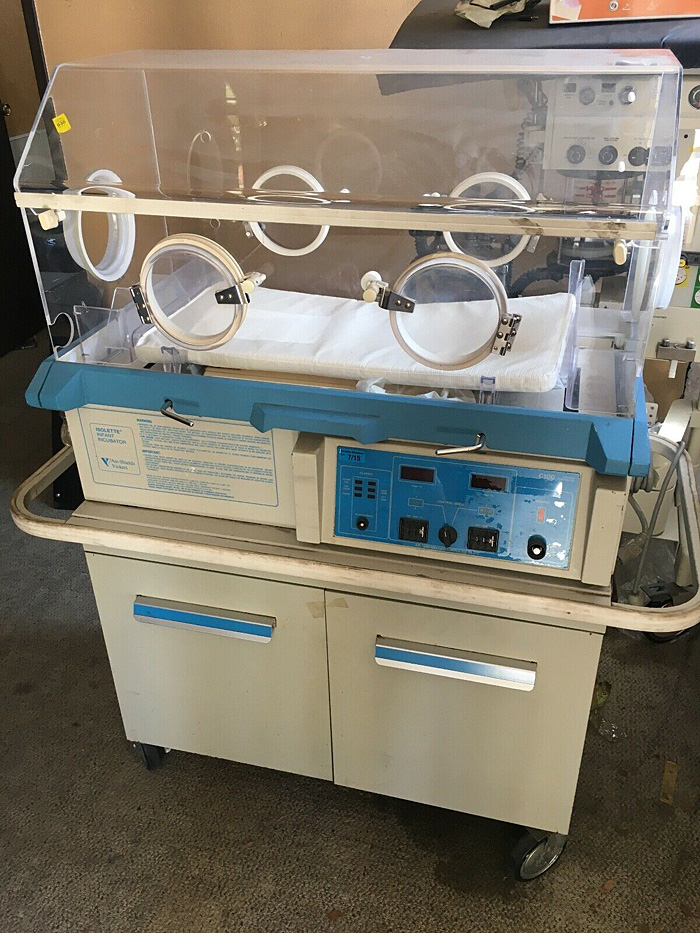
Above: Air-Shields CT-100 incubator. These relatively low-tech incubators (or “isolettes”) have been in widespread use throughout the US for several decades and can be found in nurseries everywhere today.
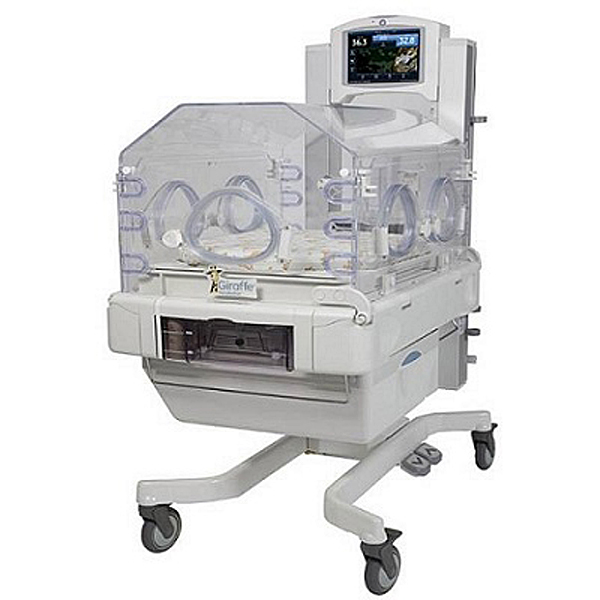
Above: The GE Ohmeda “Giraffe Bed” is a high-tech modern incubator with tight thermal regulation, servo-controlled oxygen levels, and an in-bed scale. It can be rapidly converted to an open radiant warmer for procedures, making it unnecessary to move the baby to a separate warmer.
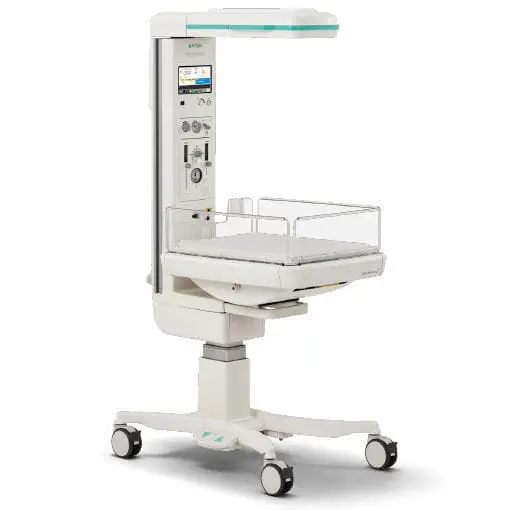
Infants are often placed in a radiant warmer when they are first admitted or very unstable. A radiant heater above the baby is controlled in a closed-loop by a skin probe, typically placed on the abdomen, that monitors the baby’s temperature. This allows excellent visibility and easy access to the baby for procedures, placing arterial lines and IVs, intubation, etc. The sidewalls protect the baby from drafts and keep things from falling off the bed when the doctors and nurses are not working with the baby.
- Julius Hess patent for a fully enclosed incubator, 1933
- Julius Hess patent for a combined crib and incubator, 1933
- The Lion Incubator
- Incubators for Sale by Kny-Scheerer in NY ca. 1915.
- Paul Altmann Incubators
- Incubators for Sale in Paris in 1900
- The Chapple Incubator
- The Charlotte Box
- Dr. How’s Electric Incubator
- Hearson’s Thermostatic Nurse
- Les Couveuses Enfants a la Maternité
- Dr. Jean-Louis-Paul Denucé’s Incubator Cradle
- Artificial Mother for Infants, Scientific American, 1888.
- Incubators and Milk Laboratory Feeding, 1897.
- An Improved System of Incubators, Paris, 1896.
- Description of a New Incubator, 1893.
- Incubator for Children, Paris, 1883. (Auvard, French)
- About Warming Devices for Premature and Frail Young Children, 1884.
- A New Baby Incubator, 1892.
- Sloane Hospital Incubator, 1914
- Ueber Anwendung permanenter Baeder bei Neugeborenen, Franz Winckel, 1882.
- English abstract of Franz Winckel’s article
Last Updated on 05/19/24